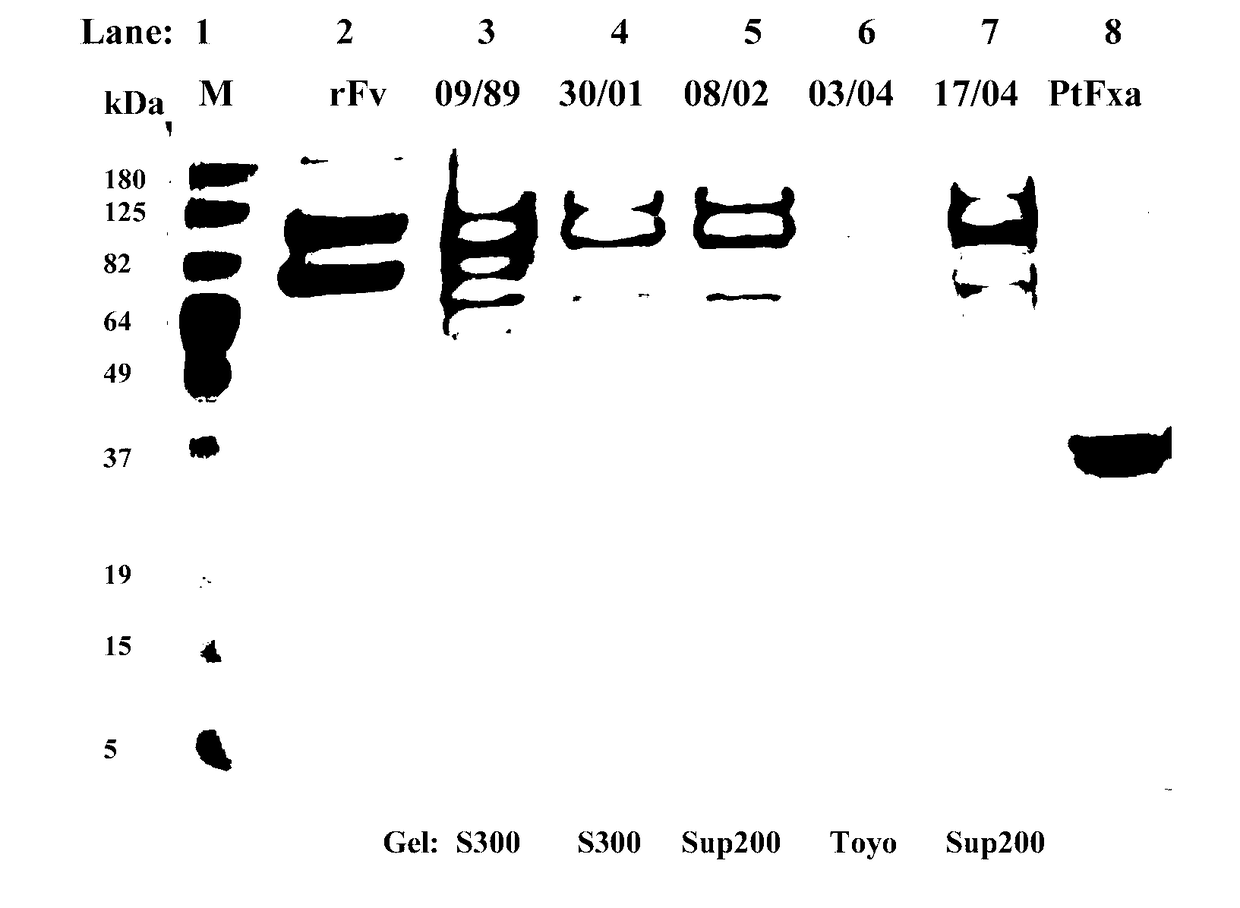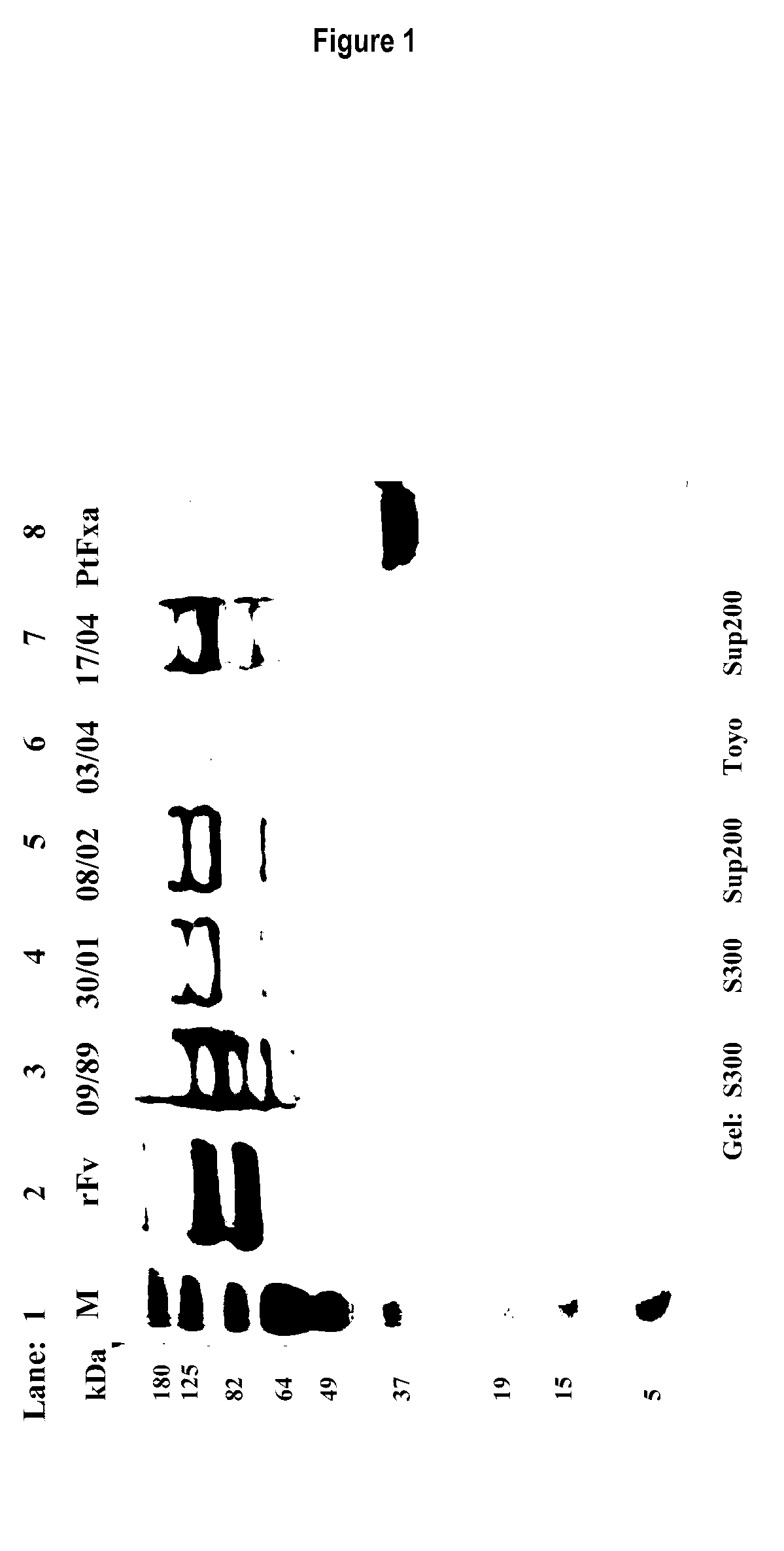Improved clotting composition
a composition and composition technology, applied in the direction of biochemistry apparatus and processes, enzymes, material testing goods, etc., can solve the problems of affecting the stability of a clotting composition, and affecting the clotting process, so as to achieve the highest percentage homology, contribute to the stability of a clotting composition, and prolong the
- Summary
- Abstract
- Description
- Claims
- Application Information
AI Technical Summary
Benefits of technology
Problems solved by technology
Method used
Image
Examples
example 1
Prothrombin Activators: Isolation and Characterisation
[0340]In mammals. the prothrombin-activator complex in vivo typically consists of a serine protease, Factor Xa, and a protein cofactor, Factor Va, complexed on a phospholipid membrane in the presence of calcium ions (Jackson and Suttie, 1977). Factor Xa alone activates prothrombin, but inefficiently. In the presence of Factor Va, calcium ions and phospholipid, prothrombin activation is enhanced by several orders of magnitude.
[0341]It is well known that the venoms of many snakes cause rapid coagulation of blood. The first report of a prothrombin activator complex in snake venom was by Speijer et al (1986), who reported the discovery of a prothrombin activator complex from Oxyuranus scutellatus (Coastal Taipan) venom with at least four polypeptide chains, two of which appeared to represent a Factor Va-like component and two, joined by a disulfide bond, that represented a Factor Xa-like component.
[0342]The methodology used in the pr...
example 1.1
Purification of Prothrombin Activators
[0343]Sephacryl S-300, Superdex 200, Toyopearl H55S and Toyopearl H65Sresins were purchased from GE Healthcare Sydney and Toyo, Japan. A slurry of each resin was diluted by 150% with column buffer, 0.05 M tris-HCl, pH 7.4, containing 0.1 M NaCl and 0.01% sodium azide. Glass columns (either 5.0×95 cm; or 2.5×95 cm) were packed with each resin at 4° C. in a cold room. Columns were equilibrated overnight at flow rate 1 ml / min and absorbance at 280 nm was monitored until stable at zero (minimum of 10 column volumes of buffer between runs).
[0344]Coastal Taipan (Oxyuranus scutellatus, Os) venom (Venom Supplies Pty Ltd. South Australia) was purchased in 2×5 gram lots and the commercial supplier, Venom Supplies confirmed both 5 gram lots were from the same batch of venom milkings. Approximately 1.0-1.5 grams lots of Os venom were reconstituted in 45 mL of column buffer in a 37° C. water bath until completely dissolved. This took approximately 30 minutes...
example 1.2
Concentration and Storage of OsPA
[0346]Fractions from Superdex 200, Sephacryl S300 and Toyopearl H55S and Toyopearl H65S chromatographies which contained plasma clotting and S-2222 hydrolytic activity were pooled (designated “pooled OsPA fractions”) for characterization. Protein concentration was determined by measuring absorbance at 280 nm of the pooled OsPA fractions and using an absorption coefficient of 1.0 for 1 mg / mL solution to calculate the protein concentration in mg / mL.
[0347]Concentration of the pooled OsPA fractions was carried out using a pressurized Amicon cell Model 402 using a YM 10 membrane (mol cut off 10,000 Da) to a concentration of 2-4 mg / mL. In the initial experiments, the loss of protein in the concentration step was 20-25%. In later experiments, 5% glycerol was added to pooled OsPA containing fractions prior to concentrating with the aim of reducing losses due to protein binding. When 5% glycerol was used the loss of protein in the concentrating step was 0-5%....
PUM
| Property | Measurement | Unit |
|---|---|---|
| Time | aaaaa | aaaaa |
| Mass | aaaaa | aaaaa |
| Mass | aaaaa | aaaaa |
Abstract
Description
Claims
Application Information
 Login to View More
Login to View More - R&D
- Intellectual Property
- Life Sciences
- Materials
- Tech Scout
- Unparalleled Data Quality
- Higher Quality Content
- 60% Fewer Hallucinations
Browse by: Latest US Patents, China's latest patents, Technical Efficacy Thesaurus, Application Domain, Technology Topic, Popular Technical Reports.
© 2025 PatSnap. All rights reserved.Legal|Privacy policy|Modern Slavery Act Transparency Statement|Sitemap|About US| Contact US: help@patsnap.com



